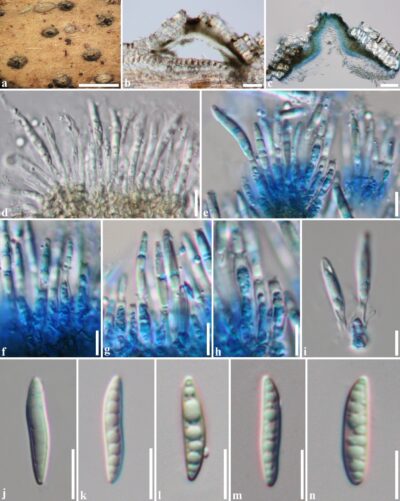Fungalpedia – Note 409, Pustulomyces
Pustulomyces D.Q. Dai, Bhat & K.D. Hyde
Citation when using this data: Tibpromma et al. 2024 (in prep.) – Fungalpedia, Ascomycota.
Index Fungorum, Facesoffungi, MycoBank, GenBank, Fig. 1
Classification: Diaporthaceae, Diaporthales, Diaporthomycetidae, Sordariomycetes, Pezizomycotina, Ascomycota, Fungi.
Based on morphology and phylogeny of LSU and TEF1-α, Pustulomyces was introduced by Dai et al. (2014) to accommodate the type species Pustulomyces bambusicola and placed it in Diaporthaceae. Pustulomyces was isolated as a saprobe from dead bamboo culms in Thailand (Dai et al. 2014). Currently, only one species of Pustulomyces is accepted, with only the asexual morph. Pustulomyces is characterized by acervular, immersed, pustule-like, acervular conidiomata with dark ostiolar necks; enteroblastic, cylindrical, slender, phialidic conidiogenous cells with a small collarette; and fusiform, straight to curved, aseptate, guttulate conidia (Dai et al. 2014). Pustulomyces is phylogenetically closely related to Phaeocytostroma and Stenocarpella spp.. However, Pustulomyces is different from Phaeocytostroma because the latter has long conidiophores, conidiogenous cells, and paraphyses (> 15 μm) (Petrak 1921, Sutton 1980, Lamprecht et al. 2011, Dai et al. 2014). Pustulomyces is different from Stenocarpella because the latter has globose to elongated conidiomata, cylindrical to narrowly ellipsoid, 1-2-septate conidia (Sutton 1980, Lamprecht et al. 2011, Dai et al. 2014). Morphologically, Pseudophialophora is similar to Bambusicola in immersed conidiomata saprobic on bamboo and short, unobtrusive conidiophores (Dai et al. 2012, 2014). However, Pustulomyces differs from phialidic conidiogenous cells and fusiform, sigmoid, and aseptate conidia, whereas Bambusicola has holoblastic and annelidic conidiogenous cells and 1-3-septate conidia (Dai et al. 2012, 2014). Pustulomyces can be distinguished from other genera based on its morphology and phylogeny.
Type species: Pustulomyces bambusicola D.Q. Dai, D.J. Bhat & K.D. Hyde
Other accepted species: This genus is monotypic.
Figure 1 – Morphological features of Pustulomyces bambusicola. a–c Conidiomata. d–i Conidiogenous cells and conidia. j–n Conidia. Scale bars a = 2 mm, b, c = 50 μm, d–n = 5 μm. Remade from Dai et al. (2014).
References
Petrak F. 1921 – Mykologische Notizen. II. Annales Mycologici 19, 17–128.
Entry by
Liu XF, Center for Yunnan Plateau Biological Resources Protection and Utilization, College of Biological Resource and Food Engineering, Qujing Normal University, Qujing, Yunnan 655011, China; Center of Excellence in Fungal Research, Mae Fah Luang University, Chiang Rai 57100, Thailand; School of Science, Mae Fah Luang University, Chiang Rai 57100, Thailand.
(Edited by Saowaluck Tibpromma, Samaneh Chaharmiri-Dokhaharani& Achala R. Rathnayaka)
Published online 26 November 2024
